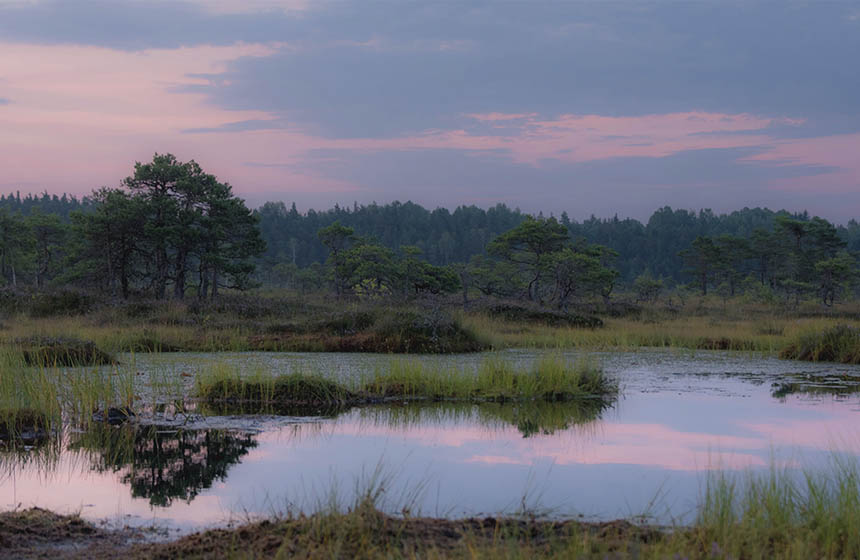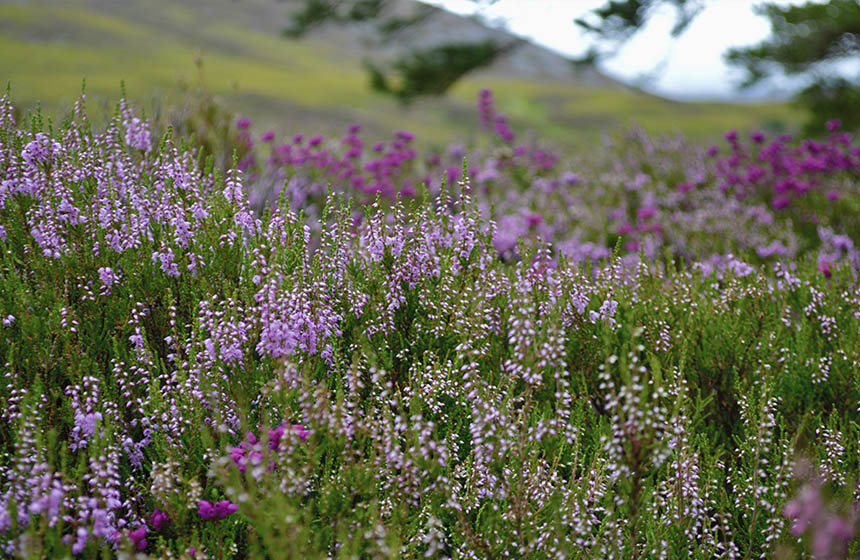The Great North Bog: a partnership for landscape-scale peatland restoration
Building on 20 years of successful peatland restoration, the Great North Bog partnership aims to use a blended finance approach to restore all of northern England’s remaining degraded upland peatlands by 2040, by bringing together a broad coalition of peatland restoration organisations to concentrate funding and resources.
Nature-based intervention:
Peat in northern England is highly degraded due to previous drainage, peat cutting, overgrazing, and burning, leading to high carbon dioxide emissions (1). Under the GNB, peatland restoration organisations in northern England are collaborating to mobilise collective resources and expertise. The GNB aims to facilitate faster and larger scale restoration, raise awareness of peatlands, build capacity of staff and contracts, widen the science base for restoration and conservation of peatlands, and diversify income streams to support restoration. They aim to achieve the restoration of all northern England’s peatlands by 2040 or sooner. Strategies include the blocking of grips (man-made drains), cutting, transporting and spreading heather brash using helicopters to reach remote locations, spreading of seed and fertiliser to increase habitat regeneration, and inoculating sphagnum moss into moors (2).
Overview of context:
Announced during COP26 in 2021, the GNB encompasses 92% of England’s upland peat (6,670 km²), including 2,150 km² of blanket bog and 4,520 km² of shallow peat. The area includes five national parks, the Peak District, Yorkshire Dales, North York Moors, Lake District, and Northumberland. Over the past 20 years, GNB partners have restored 1,100 km² of peatlands, equivalent to 20% of the total partnership area, but they now want to join together in order to rapidly increase the pace and scale of change. These ambitions are aligned with UK policies and strategies, including the Government’s 25 year plan for the environment in England, the Net Zero Strategy, and the 30×30 biodiversity goals (1).
Case effectiveness on
Climate change
Peatland soils in the GNB store between 450 million to 660 million tonnes of carbon, but were estimated to be emitting 3 million tonnes of carbon dioxide equivalent gases (CO2e) per year in 2023 (3). The main aim of the project is to reduce these carbon emissions by restoring the degraded peat. Funding already secured is estimated to enable future restoration of around 7,000 ha of peat, saving emissions of 711,080 tCO2e, and the intention is to grow this significantly through attracting further investment (3). Although the GNB project is still at an early stage, the partners have already restored over 1000 km² of peatland since the year 2000, with positive climate outcomes. For example, the Moors for the Future programme reported that revegetation of bare peat reduced peat erosion by 99%, preventing associated carbon losses (12).
The restoration of peatlands can contribute to increased resilience to floods. Restored peatlands soak up more rainwater, reducing the flow of water to downstream catchments (2). This is likely to have benefits in the GNB area, where towns such as Otley are prone to flooding. For example, the Moors for the Future programme reported that revegetation of bare peat led to a 45% reduction of peak stream flow during storms, and a 183% delay in peak discharge. Gully blocking reduced peak flow by a further 5%, and six years after addition of Sphagnum plug plants, peak discharge was reduced by 65% (relative to an untreated control), with lag time increased by 680% (12).
Ecosystem health
Ecological effect: PositiveAlongside carbon emission reductions, the GNB aims to deliver benefits for biodiversity. Although the project is at an early stage and benefits to biodiversity have not yet been reported, the partnership states that peatland restoration efforts can combat the decline in upland species (4). It is likely that measures to restore peatlands including sphagnum reintroduction can aid in increasing vegetation diversity (5). This has been demonstrated by earlier work in the area. For example, the Moors for the Future programme reported full coverage of blanket bog indicator species 10 years after initial revegetation of bare peat (12).
Socioeconomic outcomes
Runoff from degraded peatlands causes discolouration of drinking water supplies, leading to expensive water treatment costs. GNB peatlands are a source of drinking water for 15 million properties, and the partnership expects that restoration will reduce the costs involved in water treatment, as well as reducing flood risk and providing mental and physical health benefits (5).
Governance
Local participation in Governance: ActiveSix peatland restoration partnerships form the GNB coalition (7). These are the Cumbria Peat Partnership, Lancashire Peat Partnership, Moors for the Future Partnership, North Pennines AONB Partnership, Northumberland Peat Partnership and the Yorkshire Peat Partnership. The leads of each partnership work with other organisations to plan, deliver, and monitor restoration, secure local funding, position themselves as leaders and advocates for peatlands, and engage with local communities (1).
The GNB board sets the direction for the partnership, and comprises the six delivery partnerships as well as Defra, Natural England, the Environment Agency, and Water Companies. The operations group contributes to the strategic direction and carries out on the ground tasks. This team involves the GNB board as well as other National Park Authorities, AONB teams, National Trust, and RSPB. A stakeholder group facilitates the coalition of insights and consults a wider group of interested parties.
Finance
Prior to the formation of the GNB, funding came from the European Union’s LIFE and INTERREG programmes, grant schemes from the UK Government, Defra arms-length bodies, water companies, and small-scale private investment (1). The GNB aims to raise 200 million pounds over 20 years using a blended finance approach, where funding from the government unlocks private sector investment via voluntary carbon credits. In 2022, the GNB collated £9.3 million for restoration works, of which £6.9 million was awarded through the government’s Nature for Climate Fund (8). In total, from 2003 to 2022, the partnership has raised investments of £50 million.
The GNB aims to create carbon-linked revenue streams for private sector partners, where the landowner purchases Peatland Code accredited pending insurance units, and are given 25% of headline price per tCO2e upfront and an annual payment of the remaining 75%, aiming to reduce the risks involved in carbon credits (3).
This project is a part of the Strategic Investment Plan for Nature Recovery in the North of England by Nature North, which has received £500,000 from the National Lottery Heritage Fund and the Esmee Fairbairn Foundation (9).
Monitoring and evaluation
The GNB plans on conducting monitoring of restoration over 20 years, using techniques and technology from the IUCN UK Peatland Programme and the University of Manchester (10). Individual partnerships, such as the Moors for the Future Partnership, are known to conduct a research monitoring programme, sharing the results on their webpage (11).
Trade-offs and limitations
For the previous Moors for the Future programme, trade-offs have been reported from the carbon emissions associated with peatland restoration, principally from helicopter transport to bring staff and materials to the restoration sites on the remote moorlands. This was estimated to be outweighed by the immediate emission reductions due to restoration in the same year, with those benefits expected to grow over time (13). However, it is still important to try to minimise those emissions through careful project planning.
One article in the farming press suggested that sheep farmers that currently manage the peatlands in the GNB may oppose plans to restore peatlands, but it is not clear whether this has happened in practice (6).
References
- The Great North Bog. N.d. Our strategic plan. https://greatnorthbog.org.uk/strategy/
- Global Peatlands Initiative. 2021. COP26 – Working together for the Great North Bog. https://www.youtube.com/watch?v=yvKT5MpDQ0A
- The Great North Bog. 2023. Private sector partner specification and invitation to respond. https://greatnorthbog.org.uk/wp-content/uploads/2023/05/Great-North-Bog-Financing.pdf
- Great North Bog. N.d. Benefits to society. https://greatnorthbog.org.uk/about/#benefits
- MoorLIFE2020. 2017. Blanket bog frequently asked questions: Land management guidance. https://www.moorsforthefuture.org.uk/__data/assets/pdf_file/0024/87441/Blanket-bog-land-manager-guidance-FAQs-Report.pdf
- The Northern Farmer. 2021. Ambitious plans aim to create a ‘Great North Bog’. https://www.northernfarmer.co.uk/news/19220930.ambitious-plans-aim-create-great-north-bog/
- The Great North Bog. N.d. Our partners. https://greatnorthbog.org.uk/delivery-partnerships/
- Peak District National Park. 2022 – Funding success for the Great North Bog. https://www.peakdistrict.gov.uk/learning-about/news/archive/2022-press-releases/2022-news/funding-success-for-the-great-north-bog
- Nature North. 2022. Nature North summary document (October 2022). https://www.naturenorth.org.uk/resources/nature-north-summary-document/
- Yorkshire Peat Partnership. 2021. Great North Bog rises to the climate challenge. https://www.yppartnership.org.uk/news/great-north-bog-rises-climate-challenge
- Moors for the Future Partnership. N.d. Research and Monitoring. https://www.moorsforthefuture.org.uk/our-work/research-and-monitoring
- Moors for the Future Partnership. 2022. MoorLIFE 2020 Final Report: Action D2. Monitoring the biodiversity and ecosystem service impacts of restoration of degraded blanket bog sites. Chapter 1: Summary. https://www.moorsforthefuture.org.uk/__data/assets/pdf_file/0020/440228/Biodiversity-and-ecosystem-services-of-Blanket-Bogs-_Summary-Chapter_MLIFE2020_2022_web-res.pdf
- MoorLife2020 project. 20212. D5 Carbon Audit Update Report 2021, (LIFE14 NAT/UK/000070). https://www.moorsforthefuture.org.uk/__data/assets/pdf_file/0041/97979/Carbon-Audit-Update-Report-MoorLIFE-2020-2021.pdf

Intervention type
- Restoration
Ecosystem type
- Peatland
Climate change impacts addressed
- Freshwater flooding
Instigators
- Local NGO or CBO (eg. indigenous)
- National government/agency
Societal challenges
- Biodiversity conservation
- Climate change adaptation
- Climate change mitigation
- Disaster risk reduction
- Health
- Water security
Outcomes
- Food security: Not reported
- Water security: Positive
- Health: Positive
- Local economics: Not reported
- Livelihoods/goods/basic needs: Unclear
- Energy security: Not reported
- Disaster risk reduction: Positive
- Rights/empowerment/equality: Not reported
- Recreation: Positive
- Education: Positive
- Conflict and security: Not reported
- No. developmental outcomes reported: 8
Literature info
- Grey literature




